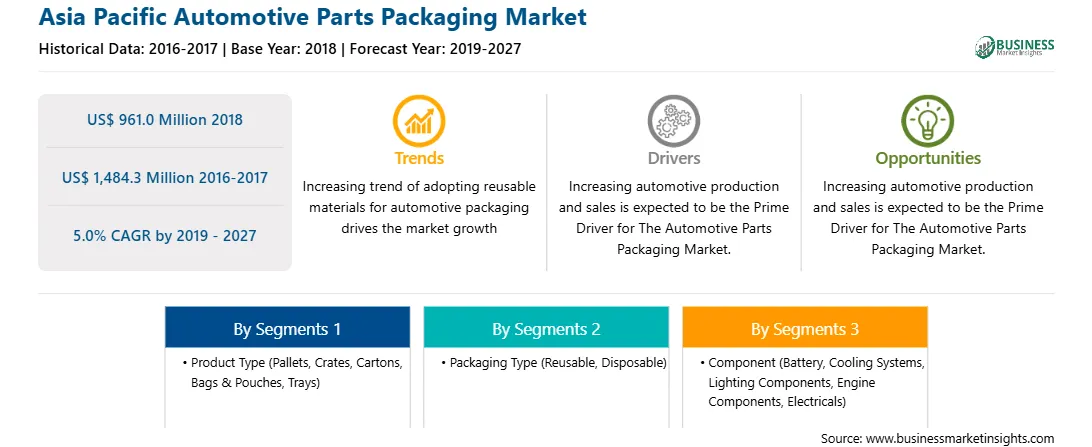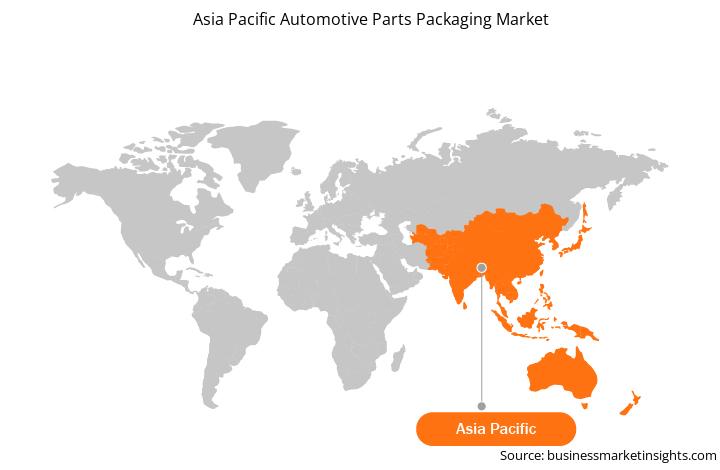The automotive parts packaging market in the Asia Pacific is expected to grow from US$ 961.0 Mn in 2018 to US$ 1,484.3 Mn by the year 2027 with a CAGR of 5.0% from the year 2019 to 2027.
The demand for aftermarket automotive parts is flourishing the growth of the automotive parts packaging market. Moreover, the emergence of several new carmakers in the electric vehicle market is anticipated to boost automotive parts packaging market growth during the forecast period. Asia Pacific region is a global automotive hubs. China accounts for approximately 30% of passenger car production globally. Lower cost of labor wages and availability of skilled workers in the region hands competitive advantage to the region for the manufacturing of automobiles.
Moreover, the Government in countries such as China and India have been rolling out favorable policies that have attracted significant foreign direct investments in the automobile and technology sector. Such a large automotive hub presents higher opportunities for the components manufacturer and suppliers by forming partnerships with the OEMs. The prosperity of these industries augurs well for the advancements in the automotive parts packaging components penetration as well. The electrification of automobiles is ushering the automotive industry and the industries associated with it to a greater extent. With the rising electric vehicle production, the requirement for a large and diversified number automotive parts and components is increasing. Geographically, China, and the US is witnessing the adoption of electric vehicles, and the growth is soaring at a rapid rate year on year.
The reusable segment is one of the leading packaging types with the highest market share in the Asia Pacific automotive parts packaging market. Reusable packaging, commonly known as returnable packaging is packaging materials that are capable of being reused in the manufacturing & distribution cycle. It involves materials like crates, racks, and pallets. Generally, the reusable packaging is used by automotive manufacturers for the shipment of body parts particularly, between component suppliers and assembly plants. The significance of these packaging systems lies in the mutual effort between the parties to maximize the container usage by evading the probabilities of them to get lost, misplaces, or forgotten. In the highly competitive automotive industry, the manufacturers are following lean manufacturing process to minimize waste throughout their process to cut costs. Reusable packaging helps in reducing inventory cost.
China dominated the automotive parts packaging market in 2018 and is anticipated to lead the market across the Asia Pacific region through the forecast period, followed by Japan and India. The figure given below highlights the revenue share of the Rest of Asia Pacific in the automotive parts packaging market in the forecast period:
Exhibit: Rest of Asia Pacific Automotive Parts Packaging Market Revenue and Forecasts to 2027 (US$ Mn)
ASIA PACIFIC AUTOMOTIVE PARTS PACKAGING MARKET SEGMENTATION
Automotive parts packaging Market - Companies Mentioned
Strategic insights for the Asia Pacific Automotive Parts Packaging provides data-driven analysis of the industry landscape, including current trends, key players, and regional nuances. These insights offer actionable recommendations, enabling readers to differentiate themselves from competitors by identifying untapped segments or developing unique value propositions. Leveraging data analytics, these insights help industry players anticipate the market shifts, whether investors, manufacturers, or other stakeholders. A future-oriented perspective is essential, helping stakeholders anticipate market shifts and position themselves for long-term success in this dynamic region. Ultimately, effective strategic insights empower readers to make informed decisions that drive profitability and achieve their business objectives within the market.

| Report Attribute | Details |
|---|---|
| Market size in 2018 | US$ 961.0 Million |
| Market Size by 2027 | US$ 1,484.3 Million |
| Global CAGR (2019 - 2027) | 5.0% |
| Historical Data | 2016-2017 |
| Forecast period | 2019-2027 |
| Segments Covered |
By Product Type
|
| Regions and Countries Covered | Asia-Pacific
|
| Market leaders and key company profiles |
The geographic scope of the Asia Pacific Automotive Parts Packaging refers to the specific areas in which a business operates and competes. Understanding local distinctions, such as diverse consumer preferences (e.g., demand for specific plug types or battery backup durations), varying economic conditions, and regulatory environments, is crucial for tailoring strategies to specific markets. Businesses can expand their reach by identifying underserved areas or adapting their offerings to meet local demands. A clear market focus allows for more effective resource allocation, targeted marketing campaigns, and better positioning against local competitors, ultimately driving growth in those targeted areas.

The List of Companies
The Asia Pacific Automotive Parts Packaging Market is valued at US$ 961.0 Million in 2018, it is projected to reach US$ 1,484.3 Million by 2027.
As per our report Asia Pacific Automotive Parts Packaging Market, the market size is valued at US$ 961.0 Million in 2018, projecting it to reach US$ 1,484.3 Million by 2027. This translates to a CAGR of approximately 5.0% during the forecast period.
The Asia Pacific Automotive Parts Packaging Market report typically cover these key segments-
The historic period, base year, and forecast period can vary slightly depending on the specific market research report. However, for the Asia Pacific Automotive Parts Packaging Market report:
The Asia Pacific Automotive Parts Packaging Market is populated by several key players, each contributing to its growth and innovation. Some of the major players include:
The Asia Pacific Automotive Parts Packaging Market report is valuable for diverse stakeholders, including:
Essentially, anyone involved in or considering involvement in the Asia Pacific Automotive Parts Packaging Market value chain can benefit from the information contained in a comprehensive market report.